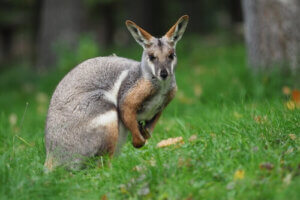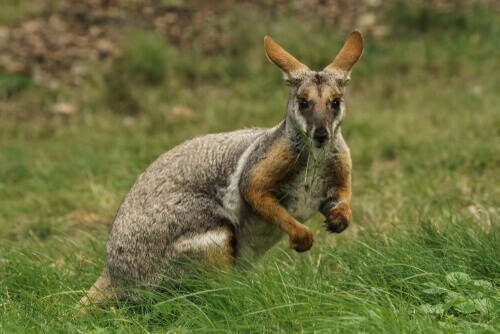The Wallaby: Discover this Amazing Marsupial


Written and verified by the lawyer Francisco María García
The wallaby is a mammal that belongs to the Macropus genus and the Macropididae family. Although it belongs to the same taxonomic family as the kangaroo, the wallaby is too small to be considered one.
Approximately 30 species belong to this family. Below, you’ll discover some of the characteristics of this amazing animal.
The physical characteristics of the wallaby
This animal is small – it only measures between 18 and 41 inches, without counting the tail, which is 13 to 30 inches long. Its weight ranges between 55 and 77 pounds. Males are bigger than females. However, the size and weight of this marsupial vary depending on its geographic location.
Its fur is usually black, gray, brown, or white. The front of its body is usually white; the ears, eyes, and legs are darker and its head is elongated. Like all marsupials, the female has a pouch in which she carries her joeys.
The hind legs of this animal are very big and have four toes. Thanks to those huge legs, it can jump great distances and kick hard in a fight. Its front legs are much shorter and have five toes, with powerful claws.
The wallaby has a surprisingly long tail, which helps with balance and counterbalance when it moves. This animal has a very unusual stomach, as it contains compartments where fermentation takes place.

The wallaby’s way of life
The wallaby is a shy and very curious animal. Although it’s usually calm, it’s also very mistrustful. It usually isn’t aggressive, but it can kick its hind legs hard if it feels threatened.
Its natural habitats are savannahs, mountains or rocky areas, and jungles. This animal mostly inhabits Australia, as well as Tasmania and New Guinea to a lesser extent. The wallaby usually sleeps more during the day, especially in the hottest hours, and feeds at night.
Most wallaby species are very sociable and congregate in small groups. During the dry season, it gathers around water sources. If in danger, this marsupial usually seeks refuge and hides. But if it has to defend itself, it’ll fight relentlessly.
This animal expresses its emotions. It can show a lot of pain in certain situations, such as if it loses its joeys. When it feels threatened, it warns its companions with thumping noises it makes with its hind legs or with its tail.
The wallaby’s diet
This animal is mostly herbivorous. Its diet consists of fruits, leaves, herbs, roots, vegetables, and also even small shrubs. The natural environment it lives in usually doesn’t have much water, meaning it has to travel great distances to get it. The wallaby also gets water from its food.

In some regions, this animal feeds in urban areas. It’s considered a pest, as it insistently destroys crops.
Reproduction
Mating occurs from one year of age, between December and February. The gestation period lasts 30 days and usually only one joey is born.
At birth, little wallabies are helpless, which is why they immediately seek their mother’s pouch for protection. They’ll stay there for a maximum period of seven months. However, they come out at times, and back in when they feel scared or threatened.
The mother and the joey develop a very strong bond. She even allows her older young to stay by her side, even if they have newborn joeys themselves. The wallaby’s body is so extraordinary that it’s capable of producing two types of milk, one for newborns and one for older young.
The differences between the wallaby and the kangaroo
Although many people confuse them or think that the wallaby is nothing more than a very small kangaroo, these animals have different characteristics.
The kangaroo’s legs are longer and its teeth are different. The color of the wallaby’s coat is more vivid and has different shades, while the kangaroo’s is more uniform.
Finally, kangaroos live much longer (20-25 years versus 11-15 for the wallaby). It’s easy to tell them apart, as wallabies are smaller in size than kangaroos.
The wallaby is a mammal that belongs to the Macropus genus and the Macropididae family. Although it belongs to the same taxonomic family as the kangaroo, the wallaby is too small to be considered one.
Approximately 30 species belong to this family. Below, you’ll discover some of the characteristics of this amazing animal.
The physical characteristics of the wallaby
This animal is small – it only measures between 18 and 41 inches, without counting the tail, which is 13 to 30 inches long. Its weight ranges between 55 and 77 pounds. Males are bigger than females. However, the size and weight of this marsupial vary depending on its geographic location.
Its fur is usually black, gray, brown, or white. The front of its body is usually white; the ears, eyes, and legs are darker and its head is elongated. Like all marsupials, the female has a pouch in which she carries her joeys.
The hind legs of this animal are very big and have four toes. Thanks to those huge legs, it can jump great distances and kick hard in a fight. Its front legs are much shorter and have five toes, with powerful claws.
The wallaby has a surprisingly long tail, which helps with balance and counterbalance when it moves. This animal has a very unusual stomach, as it contains compartments where fermentation takes place.

The wallaby’s way of life
The wallaby is a shy and very curious animal. Although it’s usually calm, it’s also very mistrustful. It usually isn’t aggressive, but it can kick its hind legs hard if it feels threatened.
Its natural habitats are savannahs, mountains or rocky areas, and jungles. This animal mostly inhabits Australia, as well as Tasmania and New Guinea to a lesser extent. The wallaby usually sleeps more during the day, especially in the hottest hours, and feeds at night.
Most wallaby species are very sociable and congregate in small groups. During the dry season, it gathers around water sources. If in danger, this marsupial usually seeks refuge and hides. But if it has to defend itself, it’ll fight relentlessly.
This animal expresses its emotions. It can show a lot of pain in certain situations, such as if it loses its joeys. When it feels threatened, it warns its companions with thumping noises it makes with its hind legs or with its tail.
The wallaby’s diet
This animal is mostly herbivorous. Its diet consists of fruits, leaves, herbs, roots, vegetables, and also even small shrubs. The natural environment it lives in usually doesn’t have much water, meaning it has to travel great distances to get it. The wallaby also gets water from its food.

In some regions, this animal feeds in urban areas. It’s considered a pest, as it insistently destroys crops.
Reproduction
Mating occurs from one year of age, between December and February. The gestation period lasts 30 days and usually only one joey is born.
At birth, little wallabies are helpless, which is why they immediately seek their mother’s pouch for protection. They’ll stay there for a maximum period of seven months. However, they come out at times, and back in when they feel scared or threatened.
The mother and the joey develop a very strong bond. She even allows her older young to stay by her side, even if they have newborn joeys themselves. The wallaby’s body is so extraordinary that it’s capable of producing two types of milk, one for newborns and one for older young.
The differences between the wallaby and the kangaroo
Although many people confuse them or think that the wallaby is nothing more than a very small kangaroo, these animals have different characteristics.
The kangaroo’s legs are longer and its teeth are different. The color of the wallaby’s coat is more vivid and has different shades, while the kangaroo’s is more uniform.
Finally, kangaroos live much longer (20-25 years versus 11-15 for the wallaby). It’s easy to tell them apart, as wallabies are smaller in size than kangaroos.
This text is provided for informational purposes only and does not replace consultation with a professional. If in doubt, consult your specialist.








